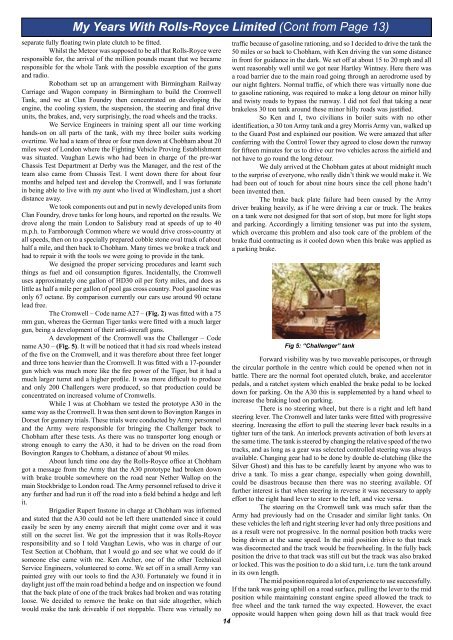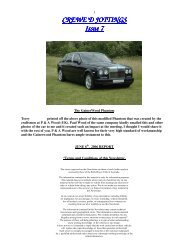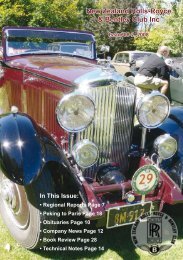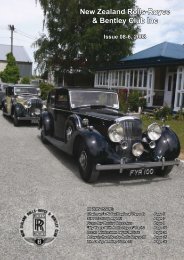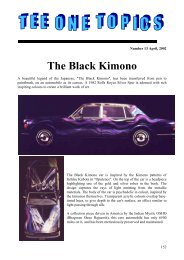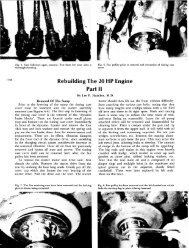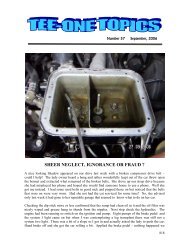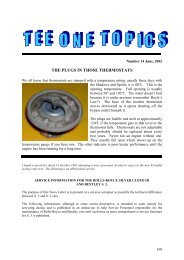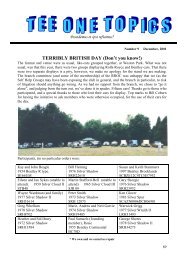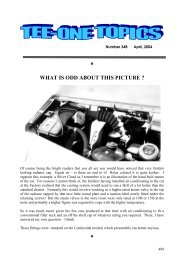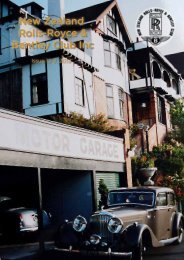New Zealand Rolls-Royce & Bentley Club Inc - KDA132
New Zealand Rolls-Royce & Bentley Club Inc - KDA132
New Zealand Rolls-Royce & Bentley Club Inc - KDA132
You also want an ePaper? Increase the reach of your titles
YUMPU automatically turns print PDFs into web optimized ePapers that Google loves.
My Years With <strong>Rolls</strong>-<strong>Royce</strong> Limited (Cont from Page 13)<br />
separate fully floating twin plate clutch to be fitted.<br />
Whilst the Meteor was supposed to be all that <strong>Rolls</strong>-<strong>Royce</strong> were<br />
responsible for, the arrival of the million pounds meant that we became<br />
responsible for the whole Tank with the possible exception of the guns<br />
and radio.<br />
Robotham set up an arrangement with Birmingham Railway<br />
Carriage and Wagon company in Birmingham to build the Cromwell<br />
Tank, and we at Clan Foundry then concentrated on developing the<br />
engine, the cooling system, the suspension, the steering and final drive<br />
units, the brakes, and, very surprisingly, the road wheels and the tracks.<br />
We Service Engineers in training spent all our time working<br />
hands-on on all parts of the tank, with my three boiler suits working<br />
overtime. We had a team of three or four men down at Chobham about 20<br />
miles west of London where the Fighting Vehicle Proving Establishment<br />
was situated. Vaughan Lewis who had been in charge of the pre-war<br />
Chassis Test Department at Derby was the Manager, and the rest of the<br />
team also came from Chassis Test. I went down there for about four<br />
months and helped test and develop the Cromwell, and I was fortunate<br />
in being able to live with my aunt who lived at Windlesham, just a short<br />
distance away.<br />
We took components out and put in newly developed units from<br />
Clan Foundry, drove tanks for long hours, and reported on the results. We<br />
drove along the main London to Salisbury road at speeds of up to 40<br />
m.p.h. to Farnborough Common where we would drive cross-country at<br />
all speeds, then on to a specially prepared cobble stone oval track of about<br />
half a mile, and then back to Chobham. Many times we broke a track and<br />
had to repair it with the tools we were going to provide in the tank.<br />
We designed the proper servicing procedures and learnt such<br />
things as fuel and oil consumption figures. <strong>Inc</strong>identally, the Cromwell<br />
uses approximately one gallon of HD30 oil per forty miles, and does as<br />
little as half a mile per gallon of pool gas cross country. Pool gasoline was<br />
only 67 octane. By comparison currently our cars use around 90 octane<br />
lead free.<br />
The Cromwell – Code name A27 – (Fig. 2) was fitted with a 75<br />
mm gun, whereas the German Tiger tanks were fitted with a much larger<br />
gun, being a development of their anti-aircraft guns.<br />
A development of the Cromwell was the Challenger – Code<br />
name A30 – (Fig. 5). It will be noticed that it had six road wheels instead<br />
of the five on the Cromwell, and it was therefore about three feet longer<br />
and three tons heavier than the Cromwell. It was fitted with a 17-pounder<br />
gun which was much more like the fire power of the Tiger, but it had a<br />
much larger turret and a higher profile. It was more difficult to produce<br />
and only 200 Challengers were produced, so that production could be<br />
concentrated on increased volume of Cromwells.<br />
While I was at Chobham we tested the prototype A30 in the<br />
same way as the Cromwell. It was then sent down to Bovington Ranges in<br />
Dorset for gunnery trials. These trials were conducted by Army personnel<br />
and the Army were responsible for bringing the Challenger back to<br />
Chobham after these tests. As there was no transporter long enough or<br />
strong enough to carry the A30, it had to be driven on the road from<br />
Bovington Ranges to Chobham, a distance of about 90 miles.<br />
About lunch time one day the <strong>Rolls</strong>-<strong>Royce</strong> office at Chobham<br />
got a message from the Army that the A30 prototype had broken down<br />
with brake trouble somewhere on the road near Nether Wallop on the<br />
main Stockbridge to London road. The Army personnel refused to drive it<br />
any further and had run it off the road into a field behind a hedge and left<br />
it.<br />
Brigadier Rupert Instone in charge at Chobham was informed<br />
and stated that the A30 could not be left there unattended since it could<br />
easily be seen by any enemy aircraft that might come over and it was<br />
still on the secret list. We got the impression that it was <strong>Rolls</strong>-<strong>Royce</strong><br />
responsibility and so I told Vaughan Lewis, who was in charge of our<br />
Test Section at Chobham, that I would go and see what we could do if<br />
someone else came with me. Ken Archer, one of the other Technical<br />
Service Engineers, volunteered to come. We set off in a small Army van<br />
painted grey with our tools to find the A30. Fortunately we found it in<br />
daylight just off the main road behind a hedge and on inspection we found<br />
that the back plate of one of the track brakes had broken and was rotating<br />
loose. We decided to remove the brake on that side altogether, which<br />
would make the tank driveable if not stoppable. There was virtually no<br />
traffic because of gasoline rationing, and so I decided to drive the tank the<br />
50 miles or so back to Chobham, with Ken driving the van some distance<br />
in front for guidance in the dark. We set off at about 15 to 20 mph and all<br />
went reasonably well until we got near Hartley Wintney. Here there was<br />
a road barrier due to the main road going through an aerodrome used by<br />
our night fighters. Normal traffic, of which there was virtually none due<br />
to gasoline rationing, was required to make a long detour on minor hilly<br />
and twisty roads to bypass the runway. I did not feel that taking a near<br />
brakeless 30 ton tank around these minor hilly roads was justified.<br />
So Ken and I, two civilians in boiler suits with no other<br />
identification, a 30 ton Army tank and a grey Morris Army van, walked up<br />
to the Guard Post and explained our position. We were amazed that after<br />
conferring with the Control Tower they agreed to close down the runway<br />
for fifteen minutes for us to drive our two vehicles across the airfield and<br />
not have to go round the long detour.<br />
We duly arrived at the Chobham gates at about midnight much<br />
to the surprise of everyone, who really didn’t think we would make it. We<br />
had been out of touch for about nine hours since the cell phone hadn’t<br />
been invented then.<br />
The brake back plate failure had been caused by the Army<br />
driver braking heavily, as if he were driving a car or truck. The brakes<br />
on a tank were not designed for that sort of stop, but more for light stops<br />
and parking. Accordingly a limiting tensioner was put into the system,<br />
which overcame this problem and also took care of the problem of the<br />
brake fluid contracting as it cooled down when this brake was applied as<br />
a parking brake.<br />
Fig 5: “Challenger” tank<br />
Forward visibility was by two moveable periscopes, or through<br />
the circular porthole in the centre which could be opened when not in<br />
battle. There are the normal foot operated clutch, brake, and accelerator<br />
pedals, and a ratchet system which enabled the brake pedal to be locked<br />
down for parking. On the A30 this is supplemented by a hand wheel to<br />
increase the braking load on parking.<br />
There is no steering wheel, but there is a right and left hand<br />
steering lever. The Cromwell and later tanks were fitted with progressive<br />
steering. <strong>Inc</strong>reasing the effort to pull the steering lever back results in a<br />
tighter turn of the tank. An interlock prevents activation of both levers at<br />
the same time. The tank is steered by changing the relative speed of the two<br />
tracks, and as long as a gear was selected controlled steering was always<br />
available. Changing gear had to be done by double de-clutching (like the<br />
Silver Ghost) and this has to be carefully learnt by anyone who was to<br />
drive a tank. To miss a gear change, especially when going downhill,<br />
could be disastrous because then there was no steering available. Of<br />
further interest is that when steering in reverse it was necessary to apply<br />
effort to the right hand lever to steer to the left, and vice versa.<br />
The steering on the Cromwell tank was much safer than the<br />
Army had previously had on the Crusader and similar light tanks. On<br />
these vehicles the left and right steering lever had only three positions and<br />
as a result were not progressive. In the normal position both tracks were<br />
being driven at the same speed. In the mid position drive to that track<br />
was disconnected and the track would be freewheeling. In the fully back<br />
position the drive to that track was still cut but the track was also braked<br />
or locked. This was the position to do a skid turn, i.e. turn the tank around<br />
in its own length.<br />
The mid position required a lot of experience to use successfully.<br />
If the tank was going uphill on a road surface, pulling the lever to the mid<br />
position while maintaining constant engine speed allowed the track to<br />
free wheel and the tank turned the way expected. However, the exact<br />
opposite would happen when going down hill as that track would free<br />
14


